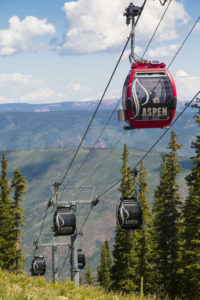 Aspen and Aspen Skiing Company both have long rich histories. There was a thriving population in this valley years before anyone dreamt of a world-class mountain resort. Here is one version of Aspen’s lively past.
Aspen and Aspen Skiing Company both have long rich histories. There was a thriving population in this valley years before anyone dreamt of a world-class mountain resort. Here is one version of Aspen’s lively past.
Over a century ago, silver prospectors braved the wilderness of the upper Roaring Fork Valley, one of the favorite summer hunting grounds of the Ute Indians, to discover one of the richest silver lodes in the world. The prospectors came from Leadville, and crossed the Continental Divide at nearly 12,100 feet. Thirteen hardy prospectors endured the winter of 1879 to protect their claims. They named the camp, Ute City, but by that spring had changed the name to Aspen.
By 1890, thousands of fortune seekers had arrived in Aspen to stake their claims. Just three years later there were more than 12,000 residents in Aspen. Even following the silver crash of 1893, one of the largest nuggets of silver was mined in 1894, weighing more than 1,800pounds. Many mining camps were temporary settlements, but Aspen residents strove for permanence. Among the many beautiful examples of Aspen’s Victorian elegance that remain in use today are the Wheeler Opera House and the Hotel Jerome.
Aspen’s fortunes fell in 1893 when Congress repealed the Sherman Act, effectively ending the silver standard. Many of the larger mines shut down and as mining declined, the local economy became more dependent upon ranching and farming. By the 1930s, Aspen’s population had shrunk to approximately 700 people and Aspen experienced the period referred to as the “Quiet Years.”
During the mid-30s, a new group of pioneers began to discover the Roaring Fork Valley, as they searched for the ideal location for a ski resort. They hired famous Swiss avalanche expert Andre Roch to survey the area and its snow. Enterprising locals constructed the original “boat tow” ski lift on Aspen Mountain. One run was cut on the face of Aspen Mountain, called Roch Run. The National Downhill and Slalom races were held on this run in 1941.
Skiing in Aspen was then spurred on by the presence of the Army’s 10th Mountain Division, who was doing their World War II training in nearby Camp Hale. Many of the early 10th Mountain Division’s soldiers, including Friedl Pfeifer, returned to Aspen following the war and began buying mining claims and surface rights with the idea of building a world-class ski area.
Financial backing was provided by Chicago industrialist Walter Paepcke. Paepcke and his wife, Elizabeth, were also interested in the community’s prospects as a summer cultural center. Aspen Skiing Corporation was formed in 1946 and Lift 1 officially opened on January 11, 1947.
In 1958, Pfeifer sold his interest in the Aspen Skiing Corporation and began to develop Buttermilk Mountain. At the same time, Whipple Van Ness Jones began building Aspen Highlands Ski Area. The Aspen Skiing Corporation bought Buttermilk in 1963 and a year later joined forces with real estate developer Bill Janss to build a fourth ski area 12 miles from Aspen. Snowmass at Aspen opened in 1967.
Aspen Skiing Corporation enjoyed growth and prosperity under the leadership of D.R.C. Brown, known as Darcy, whose father first came to Aspen in the late 1800s. 20th Century Fox bought the company in 1978. Aspen Skiing Corporation became Aspen Skiing Company in 1981, when Marvin Davis bought 20th Century Fox and it became privately held. Fox began to sell off its interest in ASC and by July 1985, the company was owned by the Crown family and a partnership called MKDG. The Crowns bought out MKDG and became sole owners in 1993.
Aspen Skiing Company began to diversify its interests in the late 80s, in response to the many changes taking place in the ski industry. ASC began construction on The Little Nell hotel in 1988 and the luxury hotel opened its doorsfor business in 1989. It is now recognized as one of the finest hotels in the world, gaining recognition as both a Forbes Five-Star and AAA Five-Diamond property. Only 53 properties in North America have achieved this level of recognition for its service facilities.
The Crowns and ASC purchased Aspen Highlands in 1993, in a joint partnership with developer Gerald Hines. The Aspen Skiing Company purchased The Limelight Lodge in April of 2010, and even though the property was completely renovated in 2008, the company made further improvements such as the addition of a restaurant, expanded amenities as well as complimentary ski programs. The company rebranded the property in 2012 as The Limelight Hotel, repositioning this Aspen institution as Aspen’s most inviting hotel.
ASC also operates 17 restaurants and 19 retail stores. Restaurants including element 47, Ajax Tavern, the Sundeck and Aspen Mountain Club on Aspen Mountain, Bumps and the Cliffhouse on Buttermilk, Cloud Nine and Merry-Go Round at Highlands and Elk Camp, Sam’s Smokehouse, Lynn Britt Cabin, Ullrhof, Up-for-Pizza, and Two Creeks on Snowmass. ASC’s retail stores are also located throughout all four mountains. Summer operations continue to be a more important part of the business, as the area has become a year-round destination resort.
Aspen Fast Facts:
Year Opened: 1947
Season bates: November 26, 2015-April 17, 2016
Base Elevation: 7,945 ft/2,422 m
Summit Elevation: 11,212 ft/3,418 m
Vertical Rise: 3,267 ft/996 m
Terrain: 675 acres/273 hectares
Number of Trails: 76
Miles/km of Trails: 64 miles/103 km
Longest Run: 3 miles/4.8 km
Steepest Run: Elevator Shaft section of the Silver Queen run-slope angle of 42
Types of Trails: Easiest- 0%, More difficult – 48%
Most difficult – 26%, Expert – 26%
Lifts: 8 Total – 6 primary – 1 six-passenger gondola: Silver Queen Gondola*; 1 high-speed quad: Ajax Express; 1 highspeed double: Ruthie’s; 1 quad: Gent’s Ridge; 2 doubles: Shadow Mountain, FIS;
2 secondary – 1 quad: Little Nell; 1 double: Bell Mountain * foot passengers permitted
Lift capacity 10,755 riders/hour




